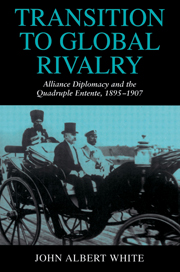Book contents
- Frontmatter
- Contents
- List of illustrations
- List of maps
- Preface
- Chronology
- List of abbreviations
- 1 Portents of conflict
- 2 The focus of hostility
- 3 The emergence of encirclement
- 4 Russia in political recession
- 5 The Algeciras factor
- 6 After Portsmouth and Algeciras
- 7 Imperial truce
- Appendices
- Bibliography
- Index
1 - Portents of conflict
Published online by Cambridge University Press: 04 August 2010
- Frontmatter
- Contents
- List of illustrations
- List of maps
- Preface
- Chronology
- List of abbreviations
- 1 Portents of conflict
- 2 The focus of hostility
- 3 The emergence of encirclement
- 4 Russia in political recession
- 5 The Algeciras factor
- 6 After Portsmouth and Algeciras
- 7 Imperial truce
- Appendices
- Bibliography
- Index
Summary
Rivalry and power
The decade of international readjustment which reached a climax in 1907 was characterized by national ambitions and political processes which portended not only fundamental change but also discord and conflict on a global scale. The emerging diplomatic order which was manifestly intended to bring about an accommodation to the new conditions was so different from the prevailing diplomatic pattern that it came to be recognized as a diplomatic revolution. The driving force in the creation of the new strategic-political structure was the emergence as regional and then world powers of Germany and Japan and, in the longer view, the United States. The principal leadership, however, which led to the diplomatic restructuring was provided by Britain, then the only actual world power.
The British motive for undertaking this mission was of course the security of the empire. However, since one of the principal threats to imperial security was the recessive role Britain had been forced for decades to play in the perennial Anglo-Russian rivalry, some alleviation of this situation was considered of the greatest importance. This antagonism had for decades defied all attempts to find a mutually acceptable solution and therewith the means of establishing a stable frontier in western Asia to protect India.
But with the expansion of German and Japanese influence and power and the corresponding intensification of international rivalries, Russia was increasingly drawn into the broader world conflict and diverted accordingly from her strategic rivalry with Britain. This in turn brought about a measure of amelioration of the British strategic preoccupation with Russia.
- Type
- Chapter
- Information
- Transition to Global RivalryAlliance Diplomacy and the Quadruple Entente, 1895–1907, pp. 1 - 42Publisher: Cambridge University PressPrint publication year: 1995



